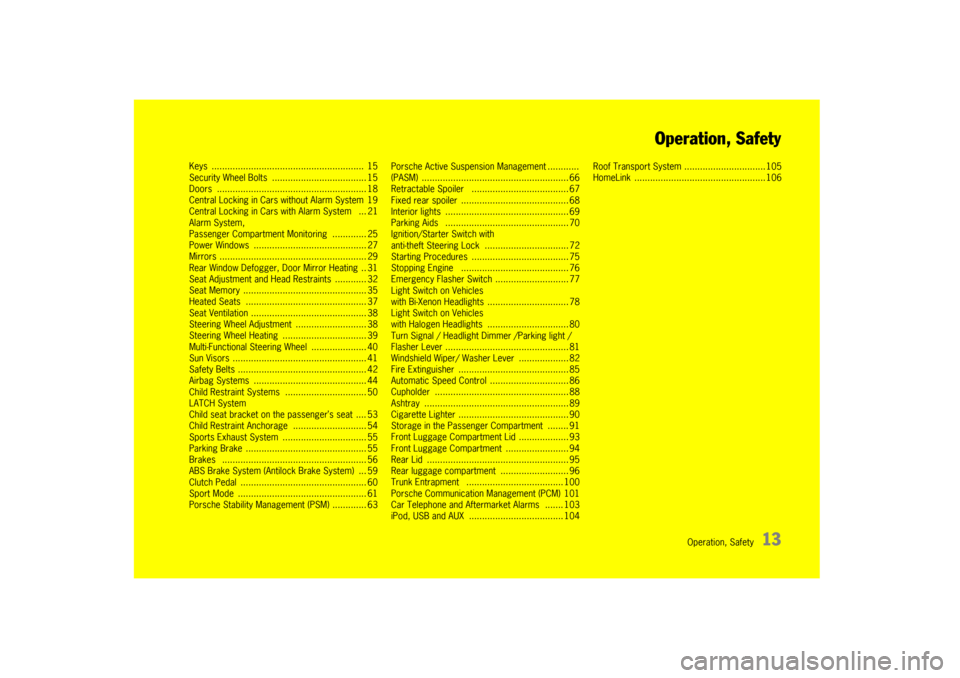wheel key PORSCHE CAYMAN 2009 1.G Owners Manual
[x] Cancel search | Manufacturer: PORSCHE, Model Year: 2009, Model line: CAYMAN, Model: PORSCHE CAYMAN 2009 1.GPages: 284, PDF Size: 5.94 MB
Page 8 of 284

6
Table of ContentsTable of ContentsPorsche Ceramic Composite Brake (PCCB) ...... 4
Setting and operating vehicle components
when driving .................................................. 4
Portable Fuel Container s ................................ 4
Ground Clearance ....... ................................... 4
Engine Exhaust ........... ................................... 5Before driving off................................. 8Before driving off... . ....................................... 8
Break in hints for the first
2,000 miles/3,000 kilo meters ...................... 10Operation, Safety ............................... 13Keys ......................................... ................. 15
Security Wheel Bolts .................................... 15
Doors ........................... .............................. 18
Central Locking in Cars without Alarm System 19
Central Locking in Cars with Alarm System ... 21
Alarm System,
Passenger Compartment Monitoring ............. 25
Power Windows ............. .............................. 27
Mirrors ...................... .................................. 29
Rear Window Defogger, Door Mirror Heating .. 31
Seat Adjustment and Head Restraints ............ 32
Seat Memory ............. .................................. 35
Heated Seats ............ .................................. 37
Seat Ventilation ...... ...................................... 38
Steering Wheel Adjust ment ........................... 38
Steering Wheel Heatin g ................................ 39
Multi-Functional Steering Wheel ..................... 40 Sun Visors ...............
....................................41
Safety Belts ............. ....................................42
Airbag Systems ....... ....................................44
Child Restraint System s ................................50
LATCH System
Child seat bracket on the passenger’s seat ....53
Child Restraint Anchorage .............. ...............54
Sports Exhaust System ................................55
Parking Brake .......... ....................................55
Brakes ................... ....................................56
ABS Brake System (Antilock Brake System) ...59
Clutch Pedal ................ ................................60
Sport Mode ................. ................................61
Porsche Stability Manage ment (PSM) .............63
Porsche Active Suspensi on Management ............
(PASM) ........................ ................................66
Rear Spoiler ........... ....................................67
Fixed rear spoiler . ........................................68
Interior lights ................................ ...............69
Parking Aids ........... ....................................70
Ignition/Starter Switch with
anti-theft Steering Lo ck .................................72
Starting Procedures .....................................75
Stopping Engine .. ........................................76
Emergency Flasher Swit ch ............................77
Light Switch on Vehicles
with Bi-Xenon Headlig hts ...............................78
Light Switch on Vehicles
with Halogen Headlights ...............................80
Turn Signal / Headlight Dimmer /Parking light /
Flasher Lever
................................ ...............81
Windshield Wiper/ Washer Lever ...................82 Fire Extinguisher ....
..................................... 85
Automatic Speed Contro l ............................. 86
Cupholder ................... ................................ 88
Ashtray ....................... ................................ 89
Cigarette Lighter .... ..................................... 90
Storage in the Passenger Compartment ........ 91
Front Luggage Compart ment Lid .................. 93
Front Luggage Compar tment ....................... 94
Rear Lid ..................... ................................ 95
Rear luggage compartm ent .......................... 96
Trunk Entrapment .. ................................... 100
Porsche Communication Management (PCM) 101
Car Telephone and Aftermarket Alarms ...... 103
iPod, USB and AUX . ................................... 104
Roof Transport System .............................. 105
HomeLink ................... .............................. 106
Automatic Air Conditioning System,
Heated Rear Window/
Door Mirror Heating. ........................ 109Air conditioning ............ ............................. 110
Automatic Air Conditioning System ............. 113
Central and Side Vents .............................. 116
Fresh-air Intake ............ ............................. 116
Heated Rear Window/
Door Mirror Heating...... ............................. 117Instruments, On-Board Computer,
Warnings ........................................ 119Instrument Panel USA Models ..................... 120
Page 15 of 284

Operation, Safety
13
Operation, Safety
Keys ................
......................... ................. 15
Security Wheel Bolts .................................... 15
Doors ........................... .............................. 18
Central Locking in Cars without Alarm System 19
Central Locking in Cars with Alarm System ... 21
Alarm System,
Passenger Compartment Monitoring ............. 25
Power Windows ............. .............................. 27
Mirrors ...................... .................................. 29
Rear Window Defogger, Door Mirror Heating .. 31
Seat Adjustment and Head Restraints ............ 32
Seat Memory ............. .................................. 35
Heated Seats ............ .................................. 37
Seat Ventilation ...... ...................................... 38
Steering Wheel Adjust ment ........................... 38
Steering Wheel Heatin g ................................ 39
Multi-Functional Steering Wheel ..................... 40
Sun Visors ................. .................................. 41
Safety Belts ............... .................................. 42
Airbag Systems ......... .................................. 44
Child Restraint System s ............................... 50
LATCH System
Child seat bracket on the passenger’s seat .... 53
Child Restraint Anchorage ............... ............. 54
Sports Exhaust System ................................ 55
Parking Brake ............ .................................. 55
Brakes ..................... .................................. 56
ABS Brake System (Antilock Brake System) ... 59
Clutch Pedal .............. .................................. 60
Sport Mode ............... .................................. 61
Porsche Stability Mana gement (PSM) ............. 63 Porsche Active Suspension Management ............
(PASM) ........................
................................ 66
Retractable Spoiler ..................................... 67
Fixed rear spoiler . ........................................ 68
Interior lights ................................ ............... 69
Parking Aids ........... .................................... 70
Ignition/Starter Switch with
anti-theft Steering Lo ck ................................ 72
Starting Procedures ..................................... 75
Stopping Engine . ........................................ 76
Emergency Flasher Swit ch ............................ 77
Light Switch on Vehicles
with Bi-Xenon Headlights ............................... 78
Light Switch on Vehicles
with Halogen Headlights ............................... 80
Turn Signal / Headlight Dimmer /Parking light /
Flasher Lever ........... .................................... 81
Windshield Wiper/ Wash er Lever
................... 82
Fire Extinguisher .. ........................................ 85
Automatic Speed Control .............................. 86
Cupholder ................... ................................ 88
Ashtray ....................... ................................ 89
Cigarette Lighter ...... .................................... 90
Storage in the Passenger Compartment ........ 91
Front Luggage Compartm ent Lid ................... 93
Front Luggage Compartm ent ........................ 94
Rear Lid .................. .................................... 95
Rear luggage compartm ent .......................... 96
Trunk Entrapment ... .................................. 100
Porsche Communication Management (PCM) 101
Car Telephone and Aftermarket Alarms ....... 103
iPod, USB and AUX .. .................................. 104 Roof Transport System
............................... 105
HomeLink ................... ............................... 106
Page 16 of 284

14
Operation, Safety
Never invite car theft! An unlocked car with the key in the ignition lock
invites car theft.
A steering wheel lock and a gong alarm are
standard equipment in your Porsche.
The gong alarm will sound if you open the driver’s
door while the key is still in the ignition lock. It is
your reminder to pull the key out of the ignition
lock and to lock the doors.
Warning!
Any uncontrolled movement of the vehicle
may result in property damage, serious per-
sonal injury or death.
Never leave your vehicle unattended with the
key in the ignition lock, especially if children
and/or pets are left unattended in the vehi-
cle. They can operate power windows and
other controls. If the engine is left running,
they may accidentally engage the shift lever.
Serious personal injury or death could result
from loss of control of the vehicle.
f Always remove the ignition key.
f Always set the parking brake.
fLock the doors with the remote control.
Warning!
Risk of a serious accident.
The steering column will lock when you re-
move the key while you are driving or as the
car is rolling to a stop. You will not be able to
steer the car.
Serious personal injury or death could result
from loss of control of the vehicle.
f Never remove the key from the steering lock while you are driving. To protect your vehicle and your possessions
from theft, you should always proceed as
follows when leaving your vehicle:
f
Close windows.
f Lock glove compartment.
f Remove ignition key.
f Close storage tray between the seats.
f Remove valuables (e.g. car documents, cell
phones, house keys) from the car.
f Lock doors.
Page 17 of 284

Operation, Safety
15
Keys fPlease see the chapter “ALARM SYSTEM, PAS-
SENGER COMPARTMENT MONITORING” on
Page 25.
f Please see the chapter “CENTRAL LOCKING IN
CARS WITHOUT ALARM SYSTEM” on Page 19.
f Please see the chapter “CENTRAL LOCKING IN
CARS WITH ALARM SYSTEM” on Page 21.
Two car keys are supplied with your Porsche.
These keys operate all the locks on your vehicle.
f Be careful with your car keys: do not part with
them except under exceptional circumstances.
f To avoid battery run-down, always remove the
ignition key from the ignition lock. Emergency operationfPlease see the chapter “EMERGENCY OPERA-
TION – PULLING OUT THE IGNITION KEY” on
Page 74.
Replacement keys Replacement car keys can be obtained only from
your authorized Porsche dealer, and this can
sometimes be very time-consuming.
You should therefore always keep a spare key on
your person.
Keep it in a safe place (e.g. wallet), but under no
circumstances in or on the vehicle.
The key codes of new keys have to be “reported”
to the car control unit by your authorized Porsche
dealer.
A total of 6 car keys can be reported to the control
unit.
Disabling key codes
If a key is lost, the key codes can be disabled by
an authorized Porsche dealer.
All the remaining car keys are required for this pur-
pose.
Disabling the code ensures that the car can be
started only using authorized keys.
Note
f Please note that the other locks can still be
opened with the disabled key.
Immobilizer There is a transponder (an electronic component)
in the key grip, conta ining a stored code.
When the ignition is switch ed on, the ignition lock
checks the code.
The immobilizer can be deactivated and the en-
gine started only using an authorized ignition key.
Switching off the immobilizer
f Insert the ignition key into the ignition lock.
If the ignition is left on for more than 2 minutes
without the engine being started, the immobilizer
is switched on again.
f If this happens, turn the ignition key back to
position 3 (ignition off) before starting the
engine. The immobilizer is switched off again,
and the engine can be started.
f Please see the chapter “IGNITION/STARTER
SWITCH WITH ANTI-THEFT STEERING LOCK”
on Page 72.
Switching on the immobilizer
f Remove ignition key.Security Wheel Bolts fIf wheels have to be removed during a work-
shop visit, do not forget to hand over the sock-
et for the security wheel bolts along with the
car key.
Page 41 of 284

Operation, Safety
39
Adjusting steering wheel height and
longitudinal direction1. Insert ignition key fully into ignition lock.
2. Push the locking lever downwards.
3. Adjust steering wheel to fit the chosen backrest angle and your seat position by
moving the steering wheel up or down and
longitudinally.
4. Swivel locking lever back until you feel it en- gage.
If necessary, move steering wheel slightly lon-
gitudinally.
Steering Wheel HeatingThe steering wheel heatin g can be switched on
and off with the button on the rear of the steering
wheel when the ignition is switched on.
Switching on steering wheel heatingf Press button.
The message “Steering wheel heating ON”
is displayed on the on-board computer for
2seconds.Switching off steering wheel heatingfPress button.
The message “Steering wheel heating OFF”
is displayed on the on-board computer for
2seconds.
Page 42 of 284

40
Operation, Safety
Multi-Functional Steering Wheel
Warning!
There is a danger of accident if you set or
operate the on-board computer, radio,
navigation system, telephone or other
equipment when driving.
Operating these devices while driving could
distract you from traffic and cause you to
lose control of the vehicle.
f Operate these components while driving only if
the traffic situation allows you to do so safely.
f Carry out any complicated operating or setting procedures only while the vehicle is stationary.
Depending on the equipment in your vehicle, you
can use the function keys of the multi-functional
steering wheel to operate the following Porsche
communication systems:
–PCM
– Telephone
– Radio with CD-Drive
–CD-Audio
Readiness for operation of multi-
functional steering wheelThe multi-functional steering wheel is ready for
operation when the ignition and PCM are switched
on.
Operating the function keysf Please read the separate PCM operating
instructions before operating the function
keys.
The rotary knobs at the top left and right of the
steering wheel can also be pressed.
Turn volume control
Upwards – increase volume.
Downwards – decrease volume.
Press volume control
To switch volume/mute on and off.
Turn rotary knob
To select/mark function in the PCM within
a menu. To do this, turn the rotary knob
upward or downward.
Press rotary knob
To activate selected function.
Press screen button
To call the stored PCM function.
The button can be assigned the desired
function in the PCM.
Press Back button
To move back in the PCM menu.
Press Handset Pickup button
To accept a telphone call.
Press Handset Hangup button
To end or refuse a telephone call.
Page 47 of 284

Operation, Safety
45
fUsing accessories not approved by Porsche
can cause the weight sensing system to be im-
paired.
f Do not squeeze objects, such as the fire extin-
guisher, or first aid kit under the seat.
f Only have seats removed and installed by an
authorized Porsche dealer so that weight sens-
ing components will not be damaged.
f Give your passenger all of the information in
this chapter.
Note
Airbag components (e.g. steering wheel, door lin-
ing, seats) may be disassembled only by an autho-
rized Porsche dealer.
When disposing of a used airbag unit, our safety
instructions must be followed. These instructions
can be obtained at any authorized Porsche dealer.
Function of the airbag systemAirbags are a supplemental safety system. Your
primary protection comes from your safety belts.
The front airbags are triggered during a frontal
collision of sufficient force and direction.
In the event of a side impact of corresponding
force, the side airbag on the impact side is
triggered.
The inflation process gene rates the amount of gas
required to fill the airbags at the necessary pres-
sure in fractions of a second.
Airbags help to protect the head and upper body,
while simultaneously damp ing the motion of the
driver and passenger in the impact direction in the
event of a frontal impact or side impact.
In order to help provide protection in severe colli-
sions which can cause death and serious injury,
airbags must inflate extremely rapidly. Such high
speed inflation has a negative but unavoidable
side effect, which is that it can and does cause in-
juries, including facial an d arm abrasions, bruising
and broken bones. You can help minimize such in-
juries by always wear ing your safety belts.
There are many types of accidents in which air-
bags are not expected to deploy. These include
accidents where the airbags would provide no be-
nefit, such as a rear impact against your vehicle.
Other accidents where the airbags are designed
not to deploy are those where the risk of injury
from the airbag deployment could exceed any pro-
tective benefits, such as in low speed accidents or higher speed accidents where the vehicle decele-
rates over a long time. Since airbag deployment
does not occur in all accidents, this further em-
phasizes the need for yo
u and your passenger to
always wear safety belts.
Your vehicle is equipped with a crash sensing and
diagnostic module. This module will record the
use of the seat belt restraint system by the driver
and passenger when the airbags and/or belt ten-
sioner work.
Advanced AirbagYour vehicle is equipped with a weight sensing sys-
tem for the passenger's seat in accordance with
U.S. Federal Motor Vehicle Safety Standard 208.
Depending on the weight acting on the passen-
ger's seat, the passenger's airbag will automati-
cally be switched on and off.
Depending on the angle and force of impact, the
passenger's airbag which is activated will be trig-
gered during a collision.
Precondition for switching the passenger's airbag
on and off, depending on weight:
– Vehicles equipped with key-operated airbag deactivation device:
Switch position AUTO.
– Ignition key is inserted.
Improper handling of the weight sensing
system can unintentional ly impair switching
the passenger's airbag off and on.
Page 75 of 284

Operation, Safety
73
Switch position 2Start engine
fTurn ignition key to ignition lock position 2 .
f Please see the chapter “STARTING PROCEDU-
RES” on Page 75.Switch position 3Ignition off
fTurn ignition key to ignition lock position 3 .
Note on operation
The vehicle battery discharges if the ignition key is
left inserted.
If the vehicle battery is dead, the key can only be
pulled out of the ignition lock if the emergency
operation is performed:
f Please see the chapter “EMERGENCY OPERA-
TION – PULLING OUT THE IGNITION KEY” on
Page 74.
Locking the steering columnAutomatic locking
The steering column is automatically locked when
the ignition key is withdrawn from the ignition lock.
Warning!
Risk of an accident, re sulting in serious per-
sonal injury or death.
The steering wheel will lock and will cause
loss of steering.
f Never remove key from the ignition lock or turn
the key off while the vehicle is moving.
f Always withdraw the ignition key when leaving the vehicle. Automatic unlocking
The steering column is unlocked when the vehicle
is unlocked with the radio remote control.
Note
f
To avoid discharging the battery, always re-
move the ignition key from the ignition lock.
Please see the chapter “BATTERY” on
Page 239.
Gong If you leave the key in the ignition/steering lock, a
gong will sound when the driver’s door is opened.
This is a reminder to remove the key.
Page 78 of 284

76
Operation, Safety
Stopping Engine fTurn key back to position 3.
f Do not stop engine immediately after hard or
extended driving.
Keep engine running at increased idle for
about two minutes to prevent excessive heat
build-up before turning off engine.
f To avoid discharging the battery, always re-
move the ignition key from the ignition lock.
f When leaving the car, always remove the igni-
tion key, apply the parking brake and engage
1st gear or reverse gear on vehicles with man-
ual transmission or move the selector lever to
position P on vehicles with PDK transmission.
f Engage the steering lock by moving the steer-
ing wheel to the left or right.
Turn the steering wheel to the locking position
before you switch off the engine so that you
don’t have to exert your self when locking or
unlocking the steering.
Warning!
Danger of injury. Hot engine compartment
components can burn skin on contact.
f Before working on any part in the engine
compartment, turn the engine off and let it cool
down sufficiently. Risk of burn injury when standing near or
coming into contact with the exhaust pipe.
The exhaust pipe is hot wh
en the vehicle is running
and remains hot for some time after the vehicle is
turned off.
f To prevent injury, make a point of noting where
your vehicle’s exhaust pipe is, avoid placing
your legs near the exhaust pipe, and closely
supervise children around the vehicle when the
exhaust pipe could be hot.
A hot exhaust pipe can cause serious burns.
Engine-compartment blower,
radiator fan The radiator and radiator fans are in the front of
the car.
The engine-compartment bl ower is mounted in the
engine compartment.
Warning!
Risk of injury.
After the engine is switched off, the engine-
compartment temperature is monitored for
approx. 30 minutes.
During this period, and depending on tem-
perature, the engine-compartment blower
may continue to run or start to run.
f Carry out work in these areas only with the en-
gine off, the ignition off, and exercise extreme
caution. Risk of injury. The radiator fans in the front
end of the car may be operating or
unexpectedly start operating when the
engine is switched on.
f
Carry out work in these areas only with the en-
gine switched off.
Automatic garage door The ignition system in your Porsche may interfere
with your electronically operated garage door.
fTo check this, drive your Porsche close to the
garage door. Make sure not to interfere with
the operating range of the door.
f Run the engine at different speeds.
f If the garage door opens or closes without you
operating the garage door unit in your car,
contact the dealer who installed the automatic
garage door to have the frequency and/or
coding of the garage door signal changed or
modified.
Page 168 of 284

166
Warnings
Warnings on the instrument panel and the on-board computerIf a warning message appears, always refer to the corresponding chapters in the Owner’s Manual.
Warning messages are issued only if all measurement preconditi ons are met. Therefore, check all fluid levels regularly –
in particular, always check the en gine oil level before refueling.
Instrument
panel On-board
computerText display on on-board
computer Meaning/measure
Seat belt
Driver and passengers must fasten their seat
belts.
Handbrake Handbrake is still on.
Ignition key
not removed
Replace battery
in ignition key Replace the remote-control battery.
Ignition lock faulty,
please go to workshop Have the fault remedied at an authorized
Porsche dealer.
Ignition lock faulty,
visit workshop now Have the fault remedied at an authorized
Porsche dealer.
Relieve steering Relieve the steering l o c k b y m o v i n g t h e s t e e r i n g
wheel to the left or right.
Steering locked The steering wheel lock remains engaged.
Have the fault remedied at an authorized
Porsche dealer.
Lights on Low beam/side marker lamps on
Parking light on Left/right parking light on